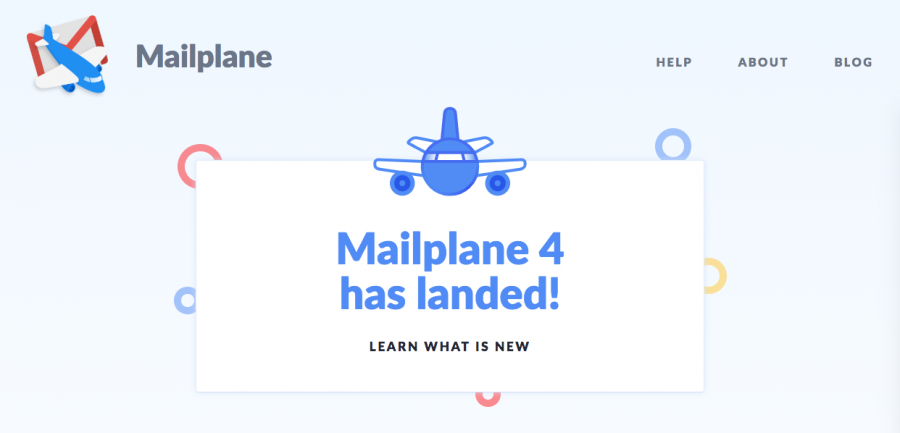
Featured Image Credit: Mailplane GmbH
Mailplane Goes Chrome and Adds Features
The Mailplane email app has long catered to Mac users who like Gmail’s Web-based interface but don’t want to forgo desktop capabilities that native mail clients provide. Mailplane is a “site-specific browser” for Gmail (see “Make Site-Specific Browsers with Google Chrome,” 6 March 2015), but it offers greater Gmail-specific functionality than a standard Web browser like Safari or Chrome. The just-released Mailplane 4 preserves these broad outlines while unveiling some significant improvements.
Mailplane 4 sports a range of usability upgrades that hook it ever more deeply into macOS, buttressing its status as an alternative to native apps such as Apple’s Mail. Simultaneously, Mailplane 4 has augmented Web capabilities that provide, among other things, better support for Google’s alternative Inbox Web mail service along with the more mainstream Gmail.
But perhaps the most significant change is that power users can now turbocharge MailPlane with supported Gmail-specific Chrome extensions, thanks to MailPlane’s switch from being built upon Safari’s WebKit rendering engine to harnessing Google’s Blink engine.
Mailplane Basics
As a site-specific browser, Mailplane lets Gmail users manage email in a window that isn’t cluttered with general browser interface elements or bogged down by unrelated Web-page tabs. Mailplane has its own toolbar, but you can hide it. Mailplane goes a bit beyond Gmail too, providing access to Google’s Inbox alternative email interface, Google Calendar, and Google Contacts, each in its own tab.
More importantly, Mailplane is in many ways a native Mac app. As Adam Engst wrote years ago, the developers have “done a truly amazing job of turning what is essentially a Web browser into a real Macintosh application” (see Zen and the Art of Gmail, Part 4: Mailplane,” 16 March 2011).
Mailplane’s longtime Mac-specific features have included Keychain support, working as your default email app, a Share menu extension, notification sounds, Quick Look previews of attachments, and more.
Usability Improvements
I have been testing Mailplane 4 for about a month, and I’ve found it to be a solid upgrade. There’s a lot to cover in terms of usability improvements, so I’ll whip through the highlights.
Tab System
The tab functionality is more flexible and user-friendly than in the past. Clicking the + button to create a new tab now opens a Load Tab page. For each configured account, the page shows buttons for Gmail, Inbox, Calendar, and Contacts. Accounts on the page are coded with user-customizable colors. You can also open multiple instances of an account’s Gmail, Inbox, Calendar, and Contacts views in separate tabs, which was not possible before.
Search
Gmail’s native search capabilities are excellent, and Mailplane 4 builds on them. Notably, you can search in multiple Gmail and Inbox accounts simultaneously. Open the app’s standalone search window, type query terms, and press Return. Each search result displays an envelope icon (closed for Gmail, open for Inbox) with a color corresponding to the message’s account. Query terms are highlighted for easier reading.
Navigation
Mailplane 4 offers a standalone Navigate window that lets you search for Gmail’s labels, which are tags that can be assigned to messages and used instead of folders, across all your accounts. Start typing in the search field and Mailplane displays labels with that text string in their names. When you find the label you want, clicking it pulls up all email messages with that label.
This feature, though not essential, is nice for those of us with lots of labels in a nested structure that can be unwieldy to navigate the traditional way.
Before you filter the list, the Navigate window shows recently used labels, which may let you avoid searching. In my case, however, it didn’t accurately show which labels I had used recently.
Notifications
Mailplane has long had Mac-native notifications, but Mailplane 4 adds actions to its notifications. For example, you can click a Reply button within the notification window to open a quick-reply field for responding right there. Similarly, you can archive a message by clicking an Archive button in the notification. You can have only one button—Reply or Archive—for all incoming messages in a particular account, but not all your accounts have to be on the same setting.
Hidden from view, there’s a nerdy way to augment this feature. At the end of a quick reply, type “/a” to reply-all, “/e” to archive the message, or “/d” to save the reply as a draft.
Annotations
Image attachments in outgoing messages now incorporate annotation controls—including arrows, text, and shapes—that stock Gmail and Inbox don’t provide. There’s also a handy text-blurring option for masking sensitive information. To use these features, click an image attachment in an email draft, and then click the Annotate button that appears.
Open In
Instead of downloading an attachment to the Desktop or another Mac folder, you can instead open it in a pre-designated default app. You can set Word documents to open in Pages, for instance, and have images open in Photos. You do this by clicking the middle of three buttons that appear when hovering over an attachment.
Even better, the right-hand … button opens a Show All Options window with an assortment of useful actions.
Clip Into
Similarly, you can export entire email conversations—including attachments and inline images—as PDF files directly into note-taking or task-management apps such as DEVONthink Pro and Evernote. You can also create tasks based on email conversations in OmniFocus, Todoist, and Things.
Mailplane 3 previously offered Evernote clipping, and even a toolbar button for that purpose, but there’s no such button—or similar ones for other relevant apps—in Mailplane 4, which is odd. However, the app does provide an Import into Evernote button among its attachment actions (see above).
Bookmarks
This simple feature lets you bookmark any email message for future reference, and you can tweak the bookmark text. This feature is not new, but Mailplane 4 makes it more visible via a menubar menu. Previously, it was buried so deeply as to be all but useless.
Mailplane’s bookmarks are an alternative to starring messages and one that is not account-specific since all bookmarks are consolidated in the Bookmarks menu. The interface can become unwieldy if you make a lot of bookmarks, though.
Inbox Support
Mailplane has long incorporated access to Inbox along with Gmail, but until recently the two services weren’t equally supported. For instance, both Gmail and Inbox in a regular browser let users determine whether to attach an image in an original or size-optimized form, but until recently Mailplane provided this feature only in Gmail. Now, parity has been achieved. Auto-BCC is another feature now supported across the board.
Other
There are a variety of less significant features as well:
- Offline: A new offline mode allows for limited functionality—such as replying to a message—without an Internet connection. The app is still largely crippled when offline, though.
- Per-account zooming: You might like Gmail, Inbox, Calendar, and Contacts set at different zoom settings, which is now possible. Previously, they shared the same zoom setting.
- Security keys: For those who use two-factor authentication, Mailplane now supports physical security keys that plug into the Mac’s USB port for a secure login.
- Keyboard shortcuts: New keyboard combos make it possible to switch tabs without resorting to a mouse or trackpad.
- Custom Gmail CSS: A Mailplane 3 feature initially dropped from Mailplane 4 but later restored, custom CSS allows Web-savvy Mailplane users to customize Gmail’s interface.
A Chrome Finish
Mailplane has been, since its inception, built atop the WebKit rendering engine used by Safari. The developers have now abandoned this approach, rebuilding Mailplane on Google’s Blink rendering engine, essentially making it a specialized version of the Google Chrome browser.
This, the developers tell me, fixes several problems. First, it makes sense to deploy Google-based services in a variation of Google’s own browser for maximum compatibility.
More importantly, a Chrome foundation makes it easier for the developers to support extensions that have long augmented browser capabilities. When it was based on WebKit, Mailplane offered a modest library of five extensions—including Boomerang to control when messages are sent and Clearbit Connect for seeing user profiles in the right-hand sidebar—but baking these capabilities into the app was a lot of work.
Migrating to Chrome reduces this coding overhead. Extensions require no modification, though Mailplane still must do some work to make them fully compatible.
It is partly for this reason that the Mailplane developers haven’t opened the floodgates to support the wide assortment of available Gmail-related Chrome extensions. The mail app supports only a dozen for now. The list includes Boomerang and Grammarly, as well as FullContact, an alternative to Clearbit Connect.
Even more extensions are on the way, but it may take time.
A Long Flight
I’ve used Mailplane as my default Mac email client for nearly a decade because I prefer Gmail’s Web-based interface to that of a desktop email client such as Apple’s Mail. Google’s Inbox is growing on me, too.
While I’d be fine using either Gmail or Inbox in Chrome, I appreciate the added Mailplane features that give it a Mac flair. It’s a win-win that has kept me loyal to the app even as I’ve tinkered with other Mac-based email clients over the years. Mailplane’s enhancements to Gmail’s stock Web-based features are great, too.
Mailplane isn’t for everyone or even every Gmail user. Some people don’t like the standard Gmail or Inbox Web interfaces, or prefer working in a native email client once they have plugged in the right Gmail settings. But if you’re a Mac user, and you’ve used Gmail or Inbox in a Web browser, I encourage you to give Mailplane a try— there’s a two-week free trial.
The app can also be a nice fit in companies, nonprofits, government agencies, and educational institutions that have deployed Google services—including Gmail and Google Calendar—but limited them to Web-based access rather than allowing their use in Apple’s Mail and other desktop applications. That’s true at my day job, for instance, but Mailplane works just fine.
My use of Mailplane 4 has been marred by a few minor quirks. It sometimes forgets its user-set window proportions. And certain Google features, such as setting the density of message lists, have worked inconsistently for me in Mailplane while functioning reliably in Chrome and other stock browsers.
But, overall, Mailplane 4 is a solid upgrade. As always, Mailplane straddles the Web and desktop worlds, filling a need that neither stock browsers nor native mail clients can fully satisfy.
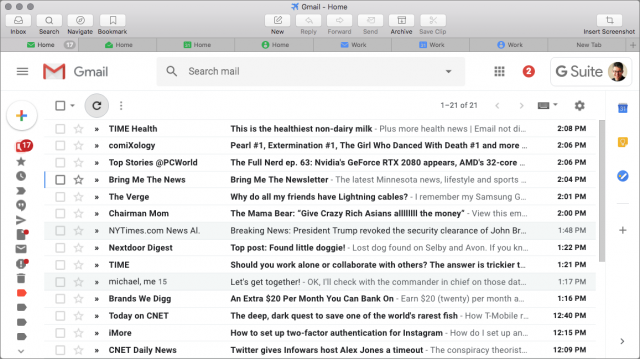
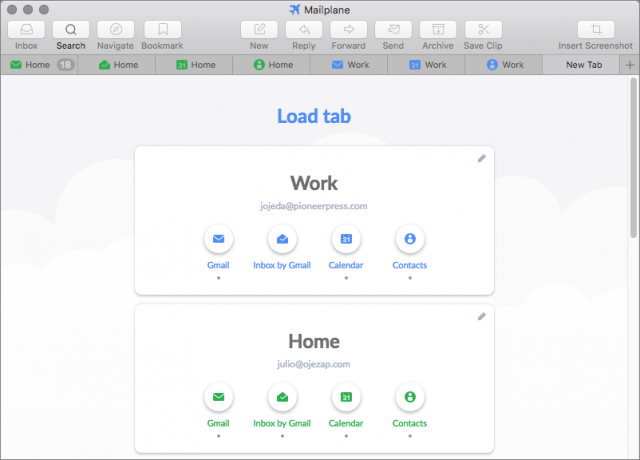
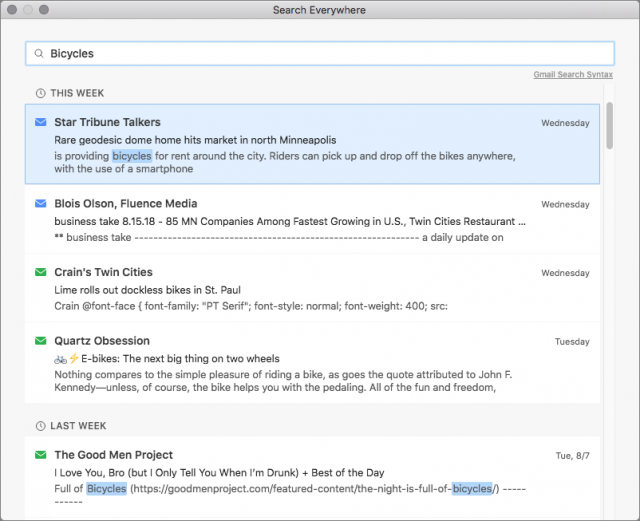
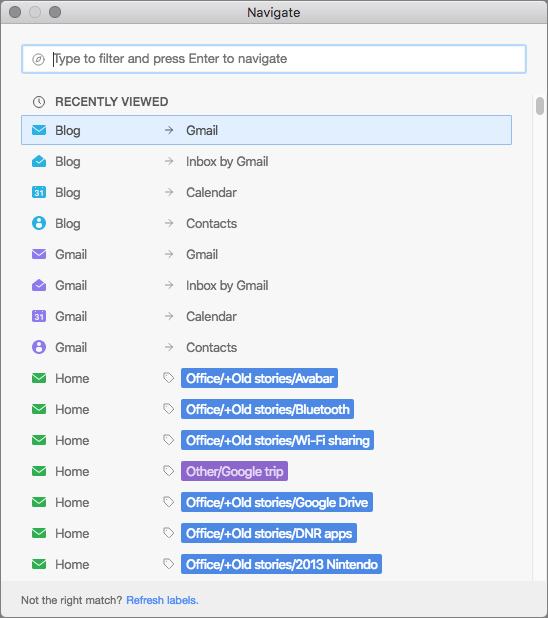
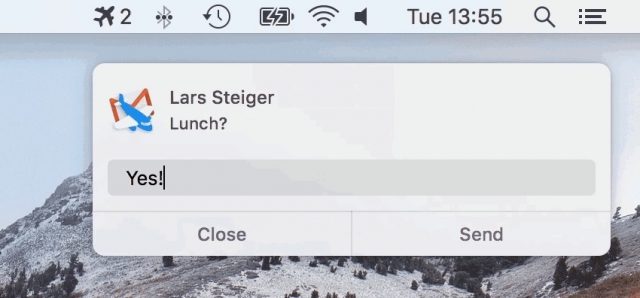
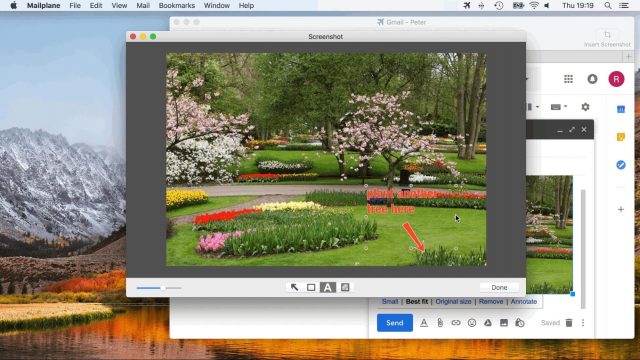

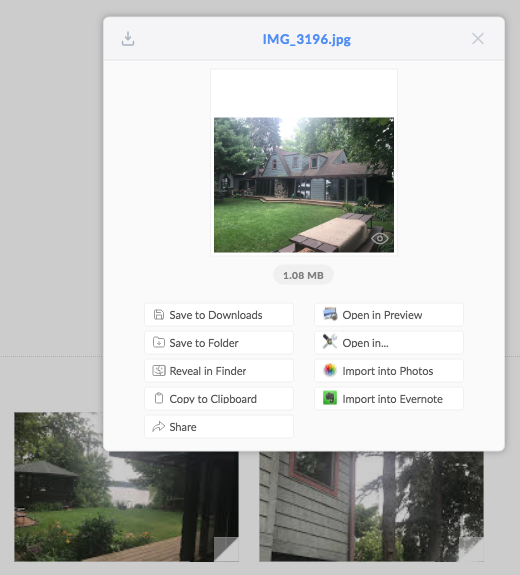
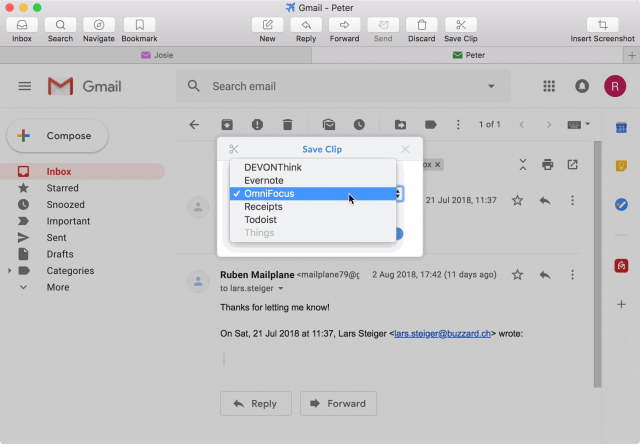

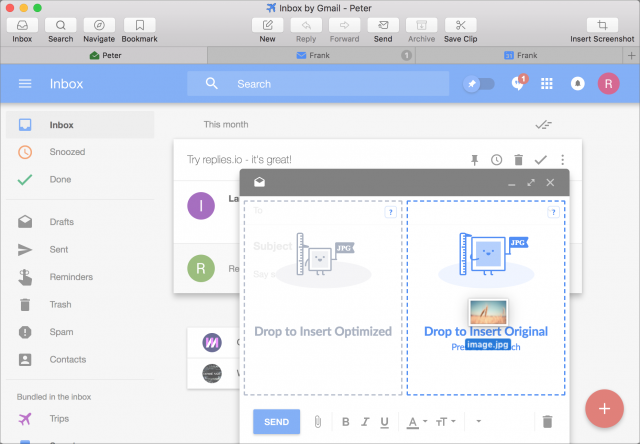
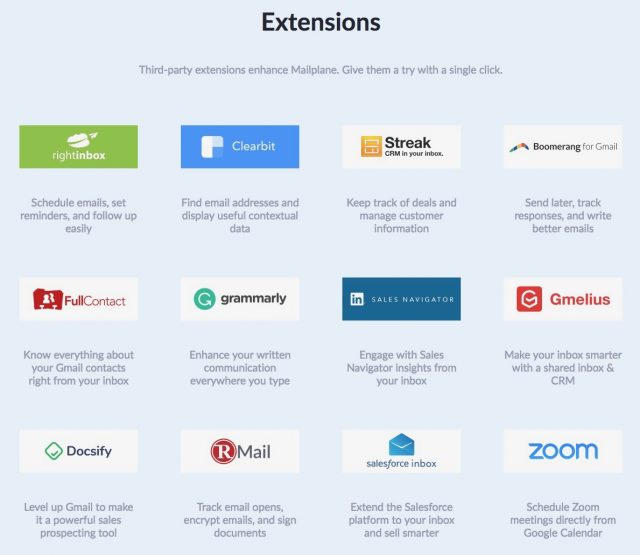
Thank you, Julio, for the informative article. Do you (or does anyone else) have recommendations for a replacement for Apple Mail for a gmail account other than Mailplane? How do the various options compare with one another? Before I pay $29.99 for mailplane, it would be good to know if there is another application that is better. BTW, I’m still using El Capitan, on a 2012 MBP.
Thank you!
I know my TidBITS editor Adam Engst has been kicking the tires on other email clients. Adam?
My concern: does Mailplane include the Chrome/GMail feature that harvests your data and sends it to Google so they can monetize you? If not, how did they strip this basic built-in “feature” from Chrome and GMail?
There are literally dozens of Gmail compatible email apps out there, and almost all of them LOOK better than Mailplane. Some are just gorgeous apps. But use them for a short time and you begin to see that the beauty is almost always skin deep.
Mailplane is the only app I’m aware of that offers multiple accounts for mail, calendar and contacts, able to view them all at once in tabs, has native Apple notifications–including for calendar items and Google Chat/Hangouts, has a Mac Share extension for easy integration with the Mac’s Finder as well as Google Docs, and the handy menubar widget which allows for quick replies. Now there’s light-duty image annotation as well.
I’ve been using it for years. I try virtually every other Gmail app upon release hoping that the better looking ones finally offer everything I need. After a week or two, I’ve always ended up switching back to Mailplane.
We all know the answer to that, so why ask? Google harvests your info, regardless of how you access it.
Exactly my take.
I’d assume Google does all of its nasty business server side so you’ll be subjected to it regardless of the client you chose. What is very effective against that, however, is just dumping them. ;)
Within certain constraints, assuming you believe Google (and if you don’t, there’s no conversation to be had about the topic). Back in July 2017, Google stopped scanning Gmail for ad-targeting reasons.
So I think it’s safe to say that Google is not monetizing Gmail by using it for ad targeting. Other data collected along the lines of what Google says it does in its privacy policy may be valuable to the company in other ways.
I’ve been playing with Spark and Astro in particular—both are free. I like Spark’s feature set and UI, but it has serious performance problems currently. Updates are coming out quickly to address that.
Astro’s UI and feature set aren’t quite as compelling, but it has no performance issues.
https://www.astro.ai/
I simply don’t like Mail, which is why I’ve used Mailplane for so many years. However, for reasons I don’t entirely understand, I’ve been seeing more lags in the Web interface for Gmail in the last few months, enough that I decided to try these other apps.
I can’t recommend anything wholeheartedly at this point, but Spark and Astro are worth a try.
Another issue with Spark for MacOS is that it’s not functionally scriptable, and for me that’s a deal breaker. I’ve asked them to add scripting, and I’m beta testing for them. I live in hope. On the iPhone, I find it very much better than Mail.
Astro isn’t scriptable either.
Jeremy
They don’t “Monetize” Gmail, but they are still collecting data, if you ask me. My reason for saying that:
I was emailing back & forth with a co-worker about standing desks in the office - this was several emails. All of a sudden, I started seeing Google adwords ads on several websites I visit for standing desks (VariDesk and one other that I don’t recall the name of). I have never been to either of their websites, so I see no other way or reason those ads would suddenly start showing up for me just a day or so after the email chain.
Spark is pretty nice looking, but along with the performance problems, I’ve read about some security issues in how they handle the email (they collect data from “commercial” emails and sell the info). Perhaps they’ve changed in the last year, but the Spark ship has sailed for me. It also doesn’t offer full Google Calendar integration.
I tried using Airmail, which also looks very nice, but it’s lack of full calendar integration and complete lack of Google Chat/Hangouts was a non-starter for me with this app as well. Again, this may have changed in the last year since I’ve used it.
I absolutely hate the Gmail interface (which obviously MailPlane uses), but I haven’t found any other app that doesn’t sacrifice full functionality for a nice GUI.
I hope you find something to your liking, and look forward to seeing your findings.
Does anyone know if Mailplane servers collect or maintain data from our Gmail accounts? I know some of the apps like Spark have to collect and store some of the email content on their servers so they can implement features like Send Later.
If Mailplane only provides the same features you would natively get through Gmail it may not need to store data on their servers (I hope).
I understand the app have access to our Gmail data but my hope is that nothing leaves my local machine and is being sent back to Mailplane headquarters.
As far as I’m aware, no, there are no “Mailplane servers.” Mailplane has always just been a front-end to the Gmail Web interface, and while you have to log in to Gmail, of course, there is no Mailplane account to log into that would store such information. And there’s no communication of Mailplane settings or the like between machines.
What you describe is true of Spark, however, and many other email apps.
Adam, have you looked at Canary Mail 2? Since Mailplane is just a MacOS shell wrapped around Gmail, perhaps a “fourth” party app might work better for those of us who have other email accounts in addition to Gmail.
I haven’t tried Canary Mail 2, no. I gave Spark a good go, but its performance just wasn’t acceptable with my account, so I went back to Mailplane.
Interestingly, I just read this thread (20200909.) Went to look at Astro, and found it was bought by Slack and shut down. That’s what happened to one of my all-time favorite Mac email clients, Sparrow. Google bought it and trashed it. I used it for many years after.
While I’ve been a Mailplane fan for years, it is a memory hog. I wish it weren’t so as I use older computers. (Never seen the need to have the lastest & greatest when what I have works well for me.)
As to Airmail, I WILL NEVER touch that app again. They continue to autoadd their own set of folders (labels) to Gmail and they have to be disposed of continually (everytime Airmail is reinstalled.)
Not a big fan of Spark, but haven’t found another app to replace it. I’ve looked at Thunderbird, Postbox, Canary and others but Spark, as much as I love to hate it, keeps me coming back. One day, I hope to find something to kick it to the curb and get it off my Mac & iOS (iPadOS) devices.
Thanks for the article and the feedback.
Google’s claims about reading the contents of Gmail turned out not to be totally straightforward. Google never denied allowing Gmail app developers and third parties access to the contents of Gmail messages. Since Mailplane is a third party, be sure to check weather or not this is true if it bothers you:
They make more money from allowing third party developers direct access to Gmail messages. Google already accumulates enough information about Gmail users from all the other tracking they do. IMHO, they have a great PR department, I think even better than Apple’s, that is brilliant in spinning information.
These articles are several years old, so let’s not revive this tangential topic and stay focused on Mailplane and alternatives.